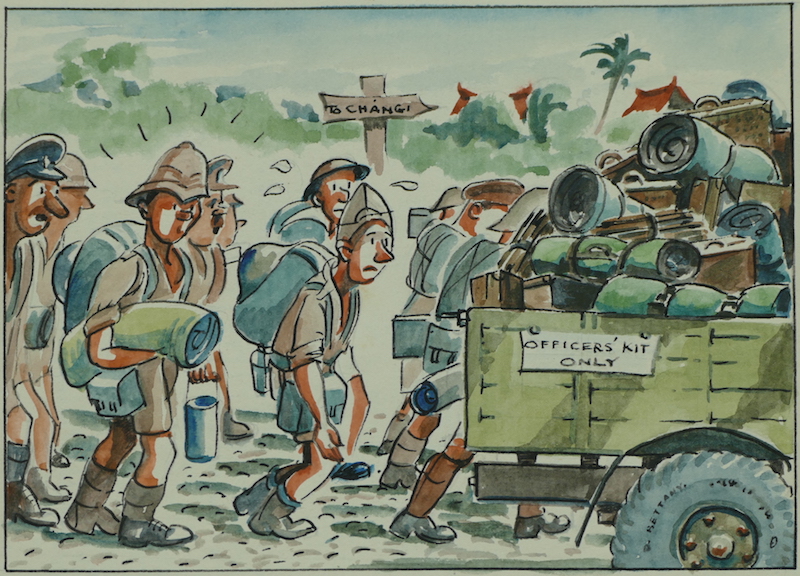‘Forced March to Changi’ Calendar Illustration for February 1946
 Forced March to Changi (Feb 17th 1942)
Forced March to Changi (Feb 17th 1942)
‘On 16 February 1942 the Japanese issued an order for the concentration of allied prisoners at Changi on the eastern extremity of Singapore Island. For the 88th this would mean a gruelling 14 mile march in the heat, with inadequate water, carrying equipment. The new prisoner compound was not one building, but a complex. The original ‘Changi Jail’ was a building designed for 600 inmates, constructed in 1936. Soon after the fall of Singapore this was occupied by European civilians, some of whom had left pathetic messages scratched into its walls. Nearby were a number of other b buildings, many of which had been used by British and Empire forces before the war. These included Selarang, Robers, Kitchener, and India Barracks, the Sime Road Camp and various workshops, batteries and stores. There was also tented accommodation in the so-called ‘Java Lines’ which were located north of India Barracks.’
Source: Lancashire Gunners at War – The 88th Field Regiment, 199 – 1945 by Stephen Bull, Pgs 84
“By late afternoon, the brief period of waiting had ended, and the men assembled to begin their passage into captivity. Over 130,000Commonwealth soldiers were taken as prisoners at the fall of Singapore (15th February 1942), the greatest defeat in British military history. They would all now march 25 kilometers, as one, to a single massive holding camp, (at Changi .”
Source: The Long Road To Changi, Ewer Peter, 2013, pg 282
“After capitulation, on the evening of 15th February 1942, the Imperial Japanese Army found themselves with a large number of Prisoners but without the means to house or feed these men.
As you can imagine on the morning of 16th February 1942, there was a very somber time. The men did not know what to expect, as they had heard of how the Japanese treated their prisoners.
Feeling naked without their arms and ammunition, a column of tired, unwashed and unshaven men moved out to march to Raffles College. There they were met by soldiers from all British, Australian and Indian Units. Food was what the men carried with them. On the afternoon of the 17th, they were ordered to march to a rendezvous where they would join the main column of prisoners to march 14 mile to their new home – Changi.”
Source: http://www.2-26bn.org/after_capitulation.htm
‘The next day we watched one of the British units passing by. There were numerous trucks bulging with officers’ mess equipment: can chairs, typewriters and no doubt a full set of cut glass, silver candlesticks, china and cutlery. Their fighting soldiers of other ranks could only bring whatever personal belongings they could carry in his own back during the long march ahead – some 25 kilometres to the Changi Peninsula. ‘
Source: A Doctors War, by Dr Rowley Richards, pg 71, Harper Collins Publishers, 2006.
Thank you: State Library of New South Wales, Mitchell Library Special Collections where this Calendar is archived
